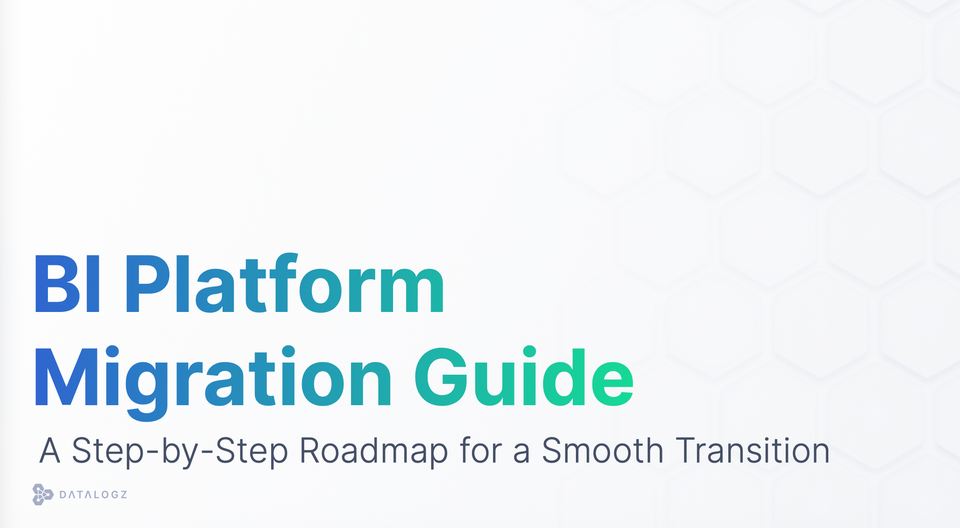BI Migrations: A Cost-Centric Guide to Getting It Right
A BI migration isn’t just a change in tools - it’s an opportunity to rethink and refine how data serves the organization. When managed carefully, BI migrations can create lasting value.

Business Intelligence (BI) migrations are often regarded as mere technical upgrades, but the reality is much broader: they’re transformative initiatives that can reshape how organizations operate. When migrating from one BI platform to another, costs are often the elephant in the room. At the outset, they’re the thing everyone hopes won’t spiral out of control. But without careful management, these migrations can become more about firefighting than progress.
Understanding and controlling these costs is vital for several reasons. First, a well-managed BI migration can unlock faster, more reliable analytics, directly impacting business performance. However, unplanned or mismanaged costs can hamper operational efficiency, delay migration timelines, and reduce the ROI of the BI platform itself.
For decision-makers, identifying and categorizing the costs associated with BI migration is the first step toward developing a proactive strategy, minimizing disruption, and maximizing value.
Types of Costs in BI Migrations
In BI migrations, expenses can arise from various sources. By understanding these distinctions, organizations can more accurately forecast expenses and identify areas to control or reduce spending. However, as with many things, it’s what we don’t see - those hidden or indirect costs - that can end up being the most significant.
Direct Costs: The direct costs of a BI migration are the most visible and easiest to track. These include licensing fees for the new BI platform, such as Power BI or Looker, alongside infrastructure changes that may involve either upgrading on-premises hardware or transitioning to cloud-based storage and processing solutions. As many organizations move from traditional platforms to cloud-first solutions, cloud storage requirements and associated costs become a notable expense. Often, these direct costs can be accurately forecasted by comparing platform pricing models and estimating infrastructure needs based on historical data volume and processing requirements.
Indirect Costs: Indirect costs, while less obvious, can accumulate significantly. These come into play when people’s time, productivity, and attention are involved. There’s the cost of staff learning a new system, adjusting workflows, and waiting while migrations affect day-to-day work. Additionally, indirect costs may include the need for increased technical support or consulting services to assist with the transition, especially if the organization has complex analytics environments or custom integrations in place. Indirect costs can stretch migration timelines and affect day-to-day operations, making it essential to consider these costs early in the planning phase.
Hidden Costs: Hidden costs are often the most challenging to anticipate and manage. These can include expenses associated with data duplication, where redundant copies of datasets are migrated unnecessarily, inflating storage costs. Similarly, there may be expenses related to the migration of outdated or obsolete assets that hold little value but add to the migration workload. For example, data sources that have become redundant over time may still be present in the legacy BI environment, leading to higher costs if they are migrated without evaluation. The catch with hidden costs is that they’re like a kind of technical debt: if you ignore them, they accrue and grow, sometimes adding years to a project’s total cost of ownership.
Factors That Influence Migration Costs
The cost of migrating isn’t fixed; it’s shaped by several factors, most of which are within an organization’s control. By understanding and optimizing these factors, you can move closer to a BI migration that’s lean and purposeful rather than bloated and reactive.
Environment Complexity: Environments with numerous data sources, custom configurations, or complex logic can drive up migration expenses due to the level of effort required to map, convert, and validate each element. For instance, organizations with custom-built dashboards or reports that depend on intricate data connections may require substantial work to re-engineer these connections within the new BI system. Additionally, the complexity of the environment impacts testing and validation, as each dependency and data flow must be reviewed and verified to ensure accuracy post-migration. Complexity is a cost multiplier, so streamlining before you start can reduce surprises later on.
Data Clean-Up Requirements: Cleaning up redundant or outdated data before migration can prevent unnecessary expenses and improve system performance in the new environment. Migrating unused or irrelevant data not only increases storage requirements but also clutters the new BI environment, potentially impacting user efficiency and analytics performance. Clean-up efforts can feel like they’re taking time away from the main migration effort, but they’re more like paying down debt. The less excess baggage you bring along, the faster and cheaper the migration.
User Management: User management is another critical factor in BI migrations, particularly in environments with a large user base. Defining access levels and identifying power users early on can help control costs associated with training and support. By segmenting users and setting appropriate access controls, organizations can optimize the user experience and reduce the need for extensive post-migration support. Additionally, focusing on user management can prevent inefficiencies that arise from granting overly broad access to users who may not require it. A structured user management plan also aids in license optimization, ensuring only essential users are provided with full licenses, while others can utilize read-only or limited access, potentially saving on licensing costs.
Common Cost Traps in BI Migrations and How to Avoid Them
Even well-planned BI migrations are vulnerable to cost traps. Recognizing these traps and having strategies to sidestep them can mean the difference between an agile project and a budget-buster.
Duplication of Assets: One common cost trap in BI migrations is the duplication of assets, where multiple copies of the same datasets, reports, or dashboards are migrated unnecessarily. This issue not only increases storage costs but also adds complexity to the new BI environment. For instance, duplicate data can lead to discrepancies in reporting and create confusion among users post-migration. Datalogz can help cut through the clutter, identifying duplicates before migration so only valuable assets make it across.
Underutilized or Redundant Licenses: Licensing tends to be one of the easiest cost traps to avoid but also one of the most overlooked. Underutilized or redundant licenses can significantly inflate migration costs if users are provided with higher access levels than necessary. By assigning appropriate license types and rights, organizations can avoid paying for redundant licenses and optimize their licensing budget. Additionally, reviewing licensing post-migration allows organizations to align costs with actual usage, potentially leading to further cost savings.
Overestimating Migration Scope: Overestimating the scope of the migration is a common cost trap that can lead to unnecessary expenses. Often, organizations plan to migrate all assets from their legacy BI environment without assessing their current relevance or value. Migrating low-use or outdated assets not only adds to the initial migration cost but also contributes to ongoing storage and maintenance costs in the new environment. Organizations can avoid this trap by carefully evaluating each asset’s value, focusing on high-priority and high-use assets, and leaving behind obsolete or low-value elements.
Strategies for Reducing BI Migration Costs
Effectively managing BI migration costs requires strategic planning, leveraging automation, and optimizing asset management. By proactively implementing these strategies, organizations can not only save on immediate expenses but also establish a more streamlined and manageable BI environment for the future.
Automation: One of the most impactful strategies for reducing BI migration costs is to leverage automation tools throughout the migration process. Such a platform can assist with metadata extraction, complexity scoring, and environment clean-up, minimizing manual efforts and reducing the risk of human error. It can also help organizations gain a detailed view of their current BI environment, allowing them to identify valuable assets, dependencies, and usage patterns. Complexity scoring evaluates the difficulty level of migrating each asset, enabling better prioritization and planning. Automation also speeds up the clean-up process by flagging redundant or outdated assets, reducing the volume of data that needs to be migrated.
Asset Lifecycle Management: It is especially beneficial in BI environments with extensive data histories, where unused or irrelevant assets might otherwise be transferred to the new platform unnecessarily. By consistently retiring, archiving, or refreshing data assets, you avoid cluttering the BI environment, making migrations cheaper and the entire BI system more agile. Integrating asset management into regular governance keeps data cleaner, so migration costs stay lower.
Optimizing Licensing and Contracts: This is an often-missed opportunity. After migration, review licensing to ensure it aligns with actual usage. BI vendors know that migrations often involve contract changes, and they’re usually open to renegotiation. Adjusting licenses based on real usage data can deliver considerable cost savings while keeping the system lean.
Long-Term Cost Benefits of an Optimized BI Migration
At its best, a BI migration isn’t just a change in tools - it’s an opportunity to rethink and refine how data serves the organization. When managed carefully, BI migrations can create lasting value. An optimized BI migration doesn’t just save money initially; it builds a more efficient environment that reduces technical debt, simplifies data use, and supports scalability.
So, think of cost management not as an afterthought but as part of a larger strategy to make BI migration work for you. Every dollar saved by reducing unnecessary assets, streamlining user access, and cleaning up data is a dollar that could be invested in deeper analysis, better tools, or more advanced insights. And that’s the true value of an optimized BI migration - it becomes an asset, not just another line item.



